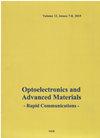Investigation of Tunable Surface Plasmon Resonances on Spheroid Core–Shell Alloy Nanoparticles Using DDA Method
IF 0.5
4区 材料科学
Q4 MATERIALS SCIENCE, MULTIDISCIPLINARY
Optoelectronics and Advanced Materials-Rapid Communications
Pub Date : 2018-07-25
DOI:10.20944/PREPRINTS201807.0480.V1
引用次数: 1
Abstract
In this work, numerical simulations for the absorption and scattering efficiencies of spheroid core–shell nanoparticles (CSNs) were conducted and studied using the discrete-dipole approximation method. The characteristics of surface plasmon resonances (SPR) depend upon shell thickness, the compositions of the core and shell materials, and the aspect ratio of the constructed CSNs. We used different core@shell compositions, specifically Au@SiO2, Ag@SiO2, Au@TiO2, Ag@TiO2, Au@Ag, and Ag@Au, for extinction spectra analysis. We also investigated coupled resonance mode wavelengths by adjusting the composition’s layer thickness and aspect ratio. In this study, we show that the extinction efficiency of the Ag@TiO2 core–shell nanoparticles (CSNPs) was higher than that of the others, and we examined the impact of TiO2 shell thickness and Ag core radius on SPR peak positions. From the extinction spectra we found that the Ag@TiO2 nanoparticle had better refractive index sensitivity and figure of merit when the aspect ratio was set to 0.3. All of the experimental results proved that the tunability of these plasmonic resonances was highly dependent on the material used, the layer thickness, and the aspect ratio of the core@shell CSNPs.球形核壳合金纳米颗粒表面等离子体共振的DDA研究
本文采用离散偶极子近似方法对球形核壳纳米粒子(CSNs)的吸收和散射效率进行了数值模拟。表面等离子体共振(SPR)的特性取决于壳层厚度、核壳材料的组成以及所构建的csn的长宽比。我们使用不同的core@shell组成,特别是Au@SiO2, Ag@SiO2, Au@TiO2, Ag@TiO2, Au@Ag和Ag@Au进行消光光谱分析。我们还通过调整组合物的层厚和长宽比来研究耦合共振模式波长。在本研究中,我们发现Ag@TiO2核壳纳米粒子(csnp)的消光效率高于其他纳米粒子,并研究了TiO2壳厚度和Ag核半径对SPR峰位置的影响。消光光谱表明,当宽高比为0.3时,Ag@TiO2纳米粒子具有较好的折射率灵敏度和优值。所有的实验结果都证明了这些等离子共振的可调性高度依赖于所用的材料、层厚度和core@shell csnp的长径比。
本文章由计算机程序翻译,如有差异,请以英文原文为准。
求助全文
约1分钟内获得全文
求助全文
来源期刊
CiteScore
0.90
自引率
20.00%
发文量
0
审稿时长
5.2 months
期刊介绍:
The Optoelectronics and Advanced Materials – Rapid Communications (Optoelectron. Adv. Mat.) appears with 12 issues per year. It is an associated letter journal to Journal of Optoelectronics and Advanced Materials. Optoelectron. Adv. Mat. is dedicated to the rapid publication of short papers and, in particular, breaking news in the field of optoelectronics, photonics, and new advanced materials (nonlinear optical materials, crystalline and non-crystalline materials, nano-structured materials, functional and smart materials, materials based on polymers, biomaterials) of relevance for optoelectronics and photonics.

 求助内容:
求助内容: 应助结果提醒方式:
应助结果提醒方式:


